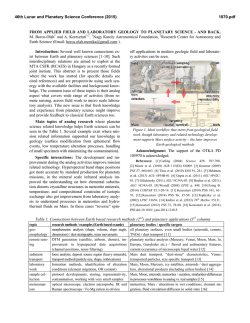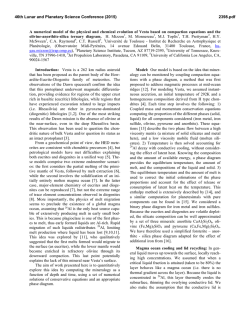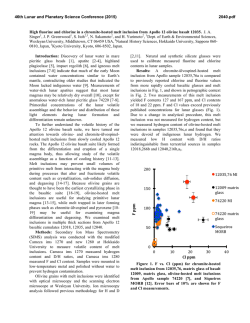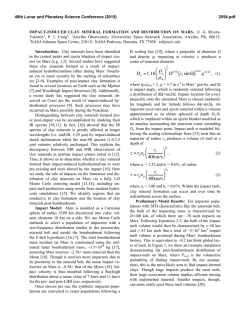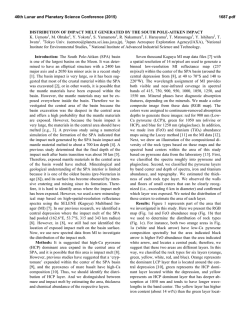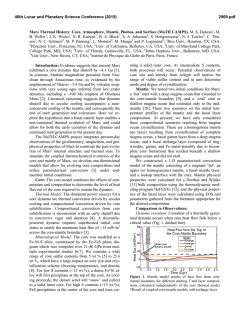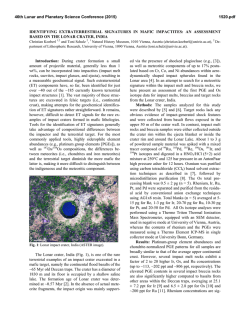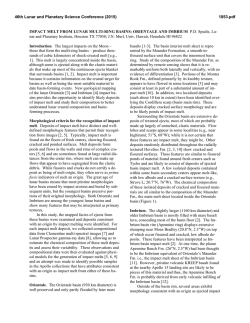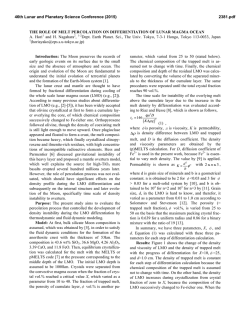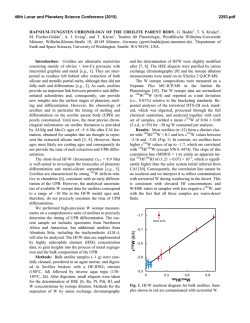
Target Strength as an Important Consideration for Low
46th Lunar and Planetary Science Conference (2015) 2727.pdf TARGET STRENGTH AS AN IMPORTANT CONSIDERATION FOR LOW-SPEED IMPACTS. S. N. Quintana1, P. H. Schultz1, D. A. Crawford2, 1Brown University Department of Earth, Environmental and Planetary Sciences, 324 Brook Street, Providence, RI 02912. 2Sandia National Laboratories, Albuquerque, NM. Introduction: In the evolution of Solar System materials, it is necessary to consider their impact history, as impacts are ubiquitous throughout the Solar System. Mars and the asteroids provide unique laboratories to study the low-speed impact process, including impact heating and melting. Background: Some low-albedo regions on Mars have been hypothesized to be volcanic in origin [e.g. 1, 2], but more recent studies have suggested these areas may be composed of impact melt products [e.g. 3-5]. In a similar vein, some authors have suggested that melt generation is not a viable process on Mars [e.g. 6], and others argue that significant heating from impacts is not a viable process on asteroids [e.g. 7]. However, various authors have demonstrated that impacts into porous materials generate enhanced impact melt and heat production [e.g. 3, 8-9]. The work presented here provides a complimentary perspective on the role of strength in impact-melt generation. Strength may be another important consideration for modeling impact melt and heating for low-speed collisions, like those on Mars and the asteroids. On the basis of impact experiments studying shear strength, some authors argue that low-speed impacts can create localized friction-induced melting along fracture zones under low peak pressures [10]. In recent computational models, particularly at low speeds (below 10 km/s), we find that the inclusion of strength increases the final release state temperature of the material and also increases the amount of melt and vapor produced in the impact. Approach: Both a one-dimensional and a twodimensional study were performed with the shock physics code CTH, developed at the Sandia National Laboratories [11]. In each case, materials tested included aluminum, basalt, dunite, granite, water ice, and iron. Impact speeds varied between 5 and 30 km/s, the lower end of which is applicable to Mars and asteroids. High-speed impact simulations provide a comparison to previous work [e.g. 12-13]. A one-dimensional study modeled a flyer plate impact where the projectile and target were composed of the same material. Pressure, temperature, and entropy were recorded throughout the impact process. Both a hydrodynamic impact calculation [13] and one including an appropriate material strength model were performed for each material and impact velocity. The one-dimensional study used the pressure-dependent yield surface strength model for geologic materials and the linearly elastic, perfectly-plastic von Mises yield surface strength model for metals. A two-dimensional study also was performed with CTH. In this case, a 1 km projectile impacted a planar, half-space target composed of the same material as the projectile. The two-dimensional impacts used axial symmetry and a vertical (90°) impact direction. Models incorporated adaptive mesh refinement (AMR) in the area immediately surrounding the impact point. AMR allows the use of higher resolution in areas of interest while keeping the rest of the domain at a relatively lower resolution, thus reducing the overall computational cost [14]. The inclusion of AMR in the hydrodynamic caluclations shows an improvement in resolution over previous work [13]. Again, both a hydrodynamic impact calculation and calculations including an appropriate material strength model were performed. As in the one-dimensaional case, strength models included the pressure-dependent yield surface strength model for geologic materials and the linearly elastic, perfectly-plastic von Mises yield surface strength model for metals. Additionally, a separate strength study used the brittle damage with localized thermal softening (BDL) model for geologic materials [15]. Results: In one-dimensional simulations, a comparison of plots of pressure vs. entropy and pressure vs. temperature for the hydrodynamic case and the strength cases highlights the role of strength in the impact. For high-speed collisions, the pressure vs. entropy and pressure vs. temperature plots for the strength cases agree well with the hydrodynamic case, indicating that strength did not have a significant effect. Conversely, at low speeds three effects emerged (Fig. 1) to indicate that strength played an important role in the impact process: the peak pressure of the system decreased, the final entropy of the system increased, and the final release-state temperature of the system increased. Because peak pressure dereased when strength was included in the simulation (even though final release-state temperature actually increased), the use of peak pressure alone as a metric for melt generation at low speeds may underestimate the amount of melt produced. In the two-dimensional study, a comparison of the mass of impact melt and vapor generated in the hydrodynamic case and strength cases suggests again that strength plays an important role in low-speed impacts. As expected from the one-dimensional models, 46th Lunar and Planetary Science Conference (2015) strength does not significantly affect melt and vapor production at high speeds for vertical impacts in two dimensions. The mass of melt and vapor produced in the high-speed models is similar to the mass of melt and vapor produced in the hydrodynamic case. Yet for low-speed two-dimensional impacts, the inclusion of a strength model yields more melting and vaporization for some materials (Fig. 2). The BDL strength model included the amount of melt produced in each cell as a cell variable in the code. This study did not account for that variable, and thus the amounts of melt generated in this study may be lower than expected. In general, the work here demonstrates that strength for lowspeed impacts is not a trivial factor. Discussion: Because our results show that entropy and final release-state temperature are elevated from results from the hydrodynamic case in low-speed impacts, strength effects should lead to increased melting, thereby increasing its importance on Mars and asteroids. Strength and porosity, in addition to localized shear heating, do play an important role in heat and melt generation [9-10]. A hydrodynamic only model may indeed underestimate the amount of melt and vapor produced in such impacts. Acknowledgements: The material herein is also based upon work partially supported by the NASA Mars Fundamental Research Program (MFRP) grant NNX13AG43G and the National Science Foundation Graduate Research Fellowship under grant number DGE-1058262. S.N.Q. also wishes to acknowledge and thank T. Daly for his insightful conversations regarding impacts on asteroids. References: [1] Bandfield, J.L. et al., (2000), Science 287, 1626-1630. [2] Christensen, P.R., et al., (2001), JGR Planets 106, 23823-23871. [3] Schultz, P.H. and Mustard, J.F. (2004), JGR Planets 109. [4] Wrobel, K.E. and Schultz, P.H. (2004), JGR 109. [5] Johnson, J.R., et al. (2006), Icarus 180, 60-74. [6] Kieffer, S.W. and Simonds, C.H. (1980), Rev. of Geophys. and Space Phys. 18, 143-181. [7] Keil K., et al. (1997), Meteorities & Planetary Sci. 32, 349-363. [8] Wunnemann, K. et al. (2008), Earth and Planetary Sci. Letters 269, 530-539. [9] Davison T.M., et al. (2012), GCA 95, 252-269. [10] van der Bogert C.H., et al. (2003) Meteoritics & Planetary Sci. 38, 1521-1531. [11] McGlaun J.M., et al. (1990), Int’l Journal of Impact Eng., 10(1-4), 351-360. [12] Pierazzo, E. et al. (1997), Icarus 127, 408-423. [13] Quinana, S.N., et al. (2013) LPSC 44, 1733. [14] Crawford, D. (1999), SNL Technical Report #SAND99-1118C. [15] Crawford, D.A. and Schultz, P.H. (2013), Large Meteorite Impacts and Planetary Evolution, 3047. 2727.pdf Figure 1 – 1D results of a 5 km/s dunite impact in pressure/temperature space. Including strength (colored curves) decreases peak pressure but increases final temperature of the material compared to the hydrodynamic case. a) b) Figure 2 – Normalized melt mass vs. melt number results from 2D low-speed strength studies using two different strength models for (a) basalt and (b) dunite. The final temperature method of melt and vapor determination [13] was used to obtain results.
© Copyright 2025
